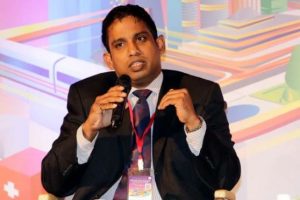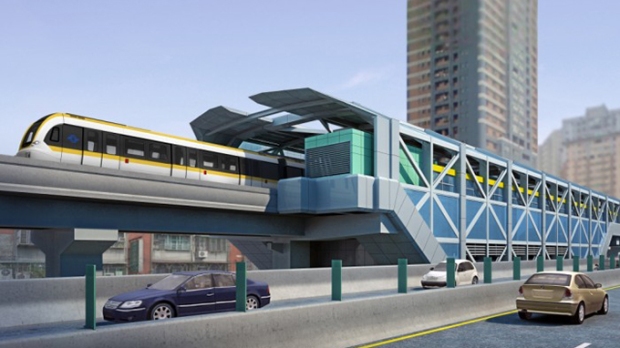20% return on investment, sustainable solution to traffic jams
Transport expert on why the government should have continued with the Colombo LRT project
By P. K. Balachandran
COLOMBO –The Japanese funded Light Railway Transport (LRT) project, abruptly and unilaterally cancelled by the Sri Lankan government in September is worthy of being persisted with believes an expert on transportation engineering, confident it would have assured a 20% return on investment in addition to providing a sustainable solution to traffic congestion to a corridor that has the highest vehicle growth and biggest traffic jams at the moment
The Sri Lankan government should not have cancelled the Japanese funded Light Railway Transport (LRT) project, believes an expert on transportation engineering, confident it would have assured a 20% return on investment in addition to providing a sustainable solution to traffic congestion to a corridor that has the highest vehicle growth and biggest traffic jams at the moment.

Dr. Dimantha de Silva, Senior Lecturer in the Transportation Engineering Division of Moratuwa University, Silva told the Daily Express, the project was worthwhile both from the point of view of present and future transport needs of Colombo and the return on investment. The elevated track would have taken a good chunk of the traffic during peak hours and would have had Rs 38 billion of economic benefit per year in terms of travel time savings and fuel cost savings or rather saved 10% of the total cost of congestion in Colombo
The government, cancelled the Japanese International Cooperation Agency (JICA)-funded Phase I of the LRT project on the grounds that it had “limited use” covering only 16.7 km from Malabe to Fort, and,(considered) at “US$ 2.2 billion” was “costly.
The partner Japanese government was neither consulted nor officially informed, diplomats said. Dismayed, they feared the cancellation and the style in which it was done might adversely affect Sri Lanka’s image as a desirable investment destination. They also said JICA, one of the major sources of funding for Sri Lanka, which did the feasibility study meticulously, might consider the rejection as a slur on its competence.
A top government official said Sri Lanka should not alienate Japan which has been a long-time friend and aid giver.
Phase I of the LRT project involved laying a 16.7 km elevated track from Malabe in the outskirts of Colombo to the Fort. The distance was to be covered in 32 minutes by a train going at 80 km per hour carrying 800 passengers per train when first operated in 2025 and 1200 passengers per train when operating in 2035.
A US$ 1.8 billion Japanese soft loan was secured (with annual interest at 0.1% for civil work and 0.01% for consultancy services), where the amount used is to be repaid in over 40 years with a 12 year grace period. The loan was not to be given in one go but in tranches from 2019 onwards. The first repayment instalment was to be given in 2030 after six years of operation and obtaining economic benefits. The last instalment of repayments was expected to be given in 2058. One of the conditions was that 30% of the products used be of Japanese origin.
The feasibility report on LRT Phase-I completed in 2018, estimated a total cost of US$ 2.2 billion, with cost components such as VAT, price escalations and price contingencies accounting for about US$ 800 million, which has been misinterpreted numerous times as the construction cost leading to the per km rate, (mis)presented as US$ 140 million per km. Dr. De Silva states the per km rate has to be calculated based on construction cost, which is estimated at feasibility stage as US$ 1.3 billion (or at US$ 85 million per km). But after detailed engineering studies, it was re-estimated that the cost would be around US$ 1 billion reducing the unit cost to US$ 62.5 million per kilometre.
De Silva explains that if the cost per kilometre appeared to be high, it was because the distance was short (just 16.7 kms), adding that the per km cost usually optimizes for around 30 km distance, since fixed cost components such as system costs for electrical and mechanical systems, communication and signal systems together with rolling stock and maintenance yard will be fixed for a length of around 30kms.
He says when the line proposed in phase 1 is extended from Malabe to Kaduwela and to Kottawa (via Athurugiriya) as per the Master Plan making it around 30kms, the per kilometre cost will come down to around US$ 50-55 million per km based on the engineering estimates completed recently.
De Silva draws attention to a comparative estimation given to another proposed LRT line of 32 kms in length based on a PPP model that was over US$ 2.1 billion. The estimate would bring the cost per kilometre of it to US$ 65.3, million making the cancelled JICA LRT cost much less than that.
As for the argument that the railways are not being used by Sri Lankans, De Silva’s counter is that people use the railway heavily when provided and more capacity increase in railway will optimize the passenger movement. According to the feasibility study, the estimated passenger trip demand for the Malabe-Fort line in 2025 is 363,000 with over 14,300 passengers per hour being transported in peak hour direction. The estimated passenger trip demand in 2035 is 498,000 with 19,800 passengers per hour in peak direction, where travel time from Malabe to Fort will be 32 minutes and from Fort to Sethsiripaya will be 18 minutes.
While the space under the elevated track can be used for commercial purposes, the elevated track obviates the need for level crossings, which if closed frequently will disrupt the smooth flow of road traffic. With thousands taking the LRT, congestion on the roads will be reduced and vehicles can move faster, cutting down on travel time and fuel use, he points out.
The government has already committed around Rs 5 billion (US$ 27 million) for consultancy. On cancellation this has to be paid immediately to JICA. Dr. De Silva refutes the argument that Japanese products cost a lot, even though their loans are cheaper; pointing out that if an alternate proposal, say at 5% interest rate, is to be considered to be equivalent or better than the JICA proposal, the alternative proposed cost has to be less than 50% of the JICA cost. The other fact that should be kept in mind is that Japanese rail cars have longevity –they last for 40 years.
Dr. De Silva claims he has not seen any analysis to support the cancellation of a project that was tender ready and would have solved the traffic congestion in this corridor by 2025. The absence of a sustainable solution to the traffic congestion problem is a concern, he says.
-P. K. Balachandran is a senior Colombo-based journalist who in the past two decades, has reported for The Hindustan Times, The New Indian Express and the Economist


